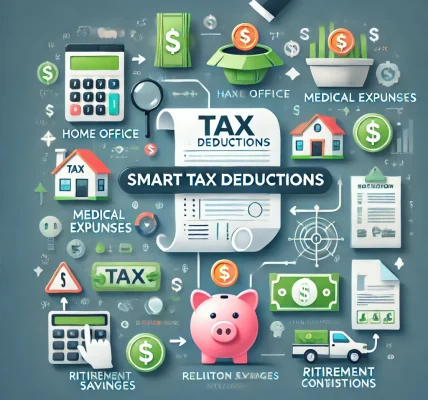Education is one of the most important investments you can make, not only for personal growth but also for financial stability. However, the cost of education can be significant, and it’s no surprise that many individuals take out education loans to fund their studies. While repaying these loans can be a burden, there’s a silver lining — education loans come with certain tax benefits that can help you save money.
In this blog, we will explore how you can leverage education loan tax benefits to reduce your taxable income, understand the relevant sections of the Income Tax Act, and get the most out of your education loan repayment.
Tax Benefits Under Section 80E
If you have taken an education loan for higher studies, Section 80E of the Income Tax Act provides tax deductions on the interest paid on the loan. This section allows you to claim deductions for the interest paid on loans taken for higher education, which can be used to reduce your taxable income.
Key Highlights of Section 80E:
- Eligibility: The deduction is available only on loans taken for higher education — this includes undergraduate, postgraduate, and professional courses.
- Interest Deduction: Under Section 80E, only the interest portion of the education loan repayment is eligible for deduction, not the principal.
- Loan for Yourself or Family: You can claim the deduction on loans taken either for yourself, your spouse, children, or a student for whom you are the legal guardian.
- No Maximum Limit: There is no maximum cap on the amount of interest that can be claimed under Section 80E. This means if your education loan interest is high, the potential tax savings could be substantial.
- Duration of Benefit: The benefit can be claimed for a maximum of 8 years or until the loan is fully repaid, whichever is earlier. This means that even if your loan repayment extends beyond 8 years, you can claim the tax deduction for the first 8 years of repayment.
Example:
If you have an education loan with an interest of ₹50,000 per year, you can claim this entire amount as a deduction under Section 80E for 8 years, provided you meet the eligibility criteria.
Who is Eligible for Education Loan Tax Deductions?
- Individuals Taking Loans: The individual who has taken the loan for higher education is eligible to claim the deduction. This includes loans taken for self-education, as well as loans taken for the education of family members, such as children or spouse.
- Loans Taken from Recognized Financial Institutions: The loan must be taken from a financial institution or a charitable trust that is recognized by the Income Tax Department. Loans from friends or relatives, or informal loans, do not qualify for this deduction.
- Loan Taken for Higher Education: The education loan must be for higher education, which is defined as education pursued after the completion of senior secondary schooling. It includes regular academic courses, professional courses, and even study abroad loans.
How Much Can You Save?
The actual tax benefit depends on your tax bracket and the interest paid on the education loan. For example:
- If you’re in the 30% tax bracket and you pay ₹50,000 in interest annually, you can save ₹15,000 per year (30% of ₹50,000).
- If you repay the loan over several years, this benefit can compound, helping you save substantial amounts over time.
Other Tax Benefits for Education Loan Borrowers
Apart from Section 80E, there are other indirect ways to maximize tax savings related to education loans:
- Home Loan Interest Deduction (for Education Loan): If you have taken an education loan and used a portion of it to purchase a house, the interest paid on that portion may be eligible for tax deductions under Section 24(b) of the Income Tax Act. This would be in addition to the deductions available under Section 80E.
- Interest on Loans for Overseas Education: If you have taken a loan for higher studies abroad, the tax benefits under Section 80E are applicable, just like loans taken for domestic education. Ensure that the loan is from a recognized institution to claim these deductions.
- EMI Payments: Some educational loans offer EMI (Equated Monthly Installment) schemes, where both principal and interest are paid in monthly installments. You can only claim the interest component of the EMI under Section 80E, which can be substantial in the initial years of the loan.
Key Points to Remember
- Claiming Deductions Only on Interest: Remember that only the interest on the education loan qualifies for tax benefits under Section 80E. The principal portion of the EMI is not eligible.
- No Age Limit for Claiming Deduction: There is no upper age limit for claiming the tax benefits, meaning even older individuals or those who return to study later in life can avail of this benefit.
- Loan Repayment in Your Name: You can only claim the deduction if you are the one repaying the loan. For example, if your parents took the loan on your behalf and you repay it, you can still claim the deduction.
- Eligible Courses: The loan should be for higher education, meaning courses after the 12th grade or equivalent. These include full-time courses, professional courses, and even part-time courses if they are recognized by the regulatory authorities.
- Documentary Proof: Keep all relevant documents, such as loan statements, repayment receipts, and interest certificates, as you will need them for claiming tax deductions.
Conclusion
Using an education loan not only helps in managing the high cost of education but can also lead to significant tax savings. By understanding the tax benefits under Section 80E, you can reduce your taxable income and save money during the loan repayment period. Remember, while the tax savings may seem small initially, over time, they can add up to substantial amounts.




